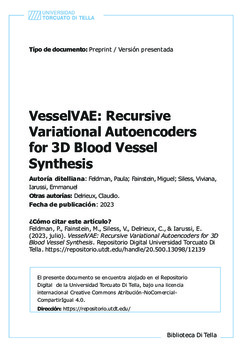| dc.rights.license | https://creativecommons.org/licenses/by-sa/2.5/ar/ | es_AR |
| dc.contributor.author | Feldman, Paula | es_AR |
| dc.contributor.author | Fainstein, Miguel | es_AR |
| dc.contributor.author | Siless, Viviana | es_AR |
| dc.contributor.author | Iarussi, Emmanuel | es_AR |
| dc.contributor.author | Delrieux, Claudio | es_AR |
| dc.date.accessioned | 2023-11-16T17:24:24Z | |
| dc.date.available | 2023-11-16T17:24:24Z | |
| dc.date.issued | 2023 | |
| dc.identifier.uri | https://repositorio.utdt.edu/handle/20.500.13098/12139 | |
| dc.description.abstract | We present a data-driven generative framework for synthesizing blood vessel 3D geometry. This is a challenging task due to the
complexity of vascular systems, which are highly variating in shape, size,
and structure. Existing model-based methods provide some degree of
control and variation in the structures produced, but fail to capture the
diversity of actual anatomical data. We developed VesselVAE, a recursive
variational Neural Network that fully exploits the hierarchical organization of the vessel and learns a low-dimensional manifold encoding branch
connectivity along with geometry features describing the target surface.
After training, the VesselVAE latent space can be sampled to generate
new vessel geometries. To the best of our knowledge, this work is the
first to utilize this technique for synthesizing blood vessels. We achieve
similarities of synthetic and real data for radius (.97), length (.95), and
tortuosity (.96). By leveraging the power of deep neural networks, we
generate 3D models of blood vessels that are both accurate and diverse,
which is crucial for medical and surgical training, hemodynamic simulations, and many other purposes.
Keywords: Vascular 3D model
· | es_AR |
| dc.format.extent | 12 p. | es_AR |
| dc.format.medium | application/pdf | es_AR |
| dc.language | eng | es_AR |
| dc.publisher | Universidad Torcuato Di Tella | es_AR |
| dc.relation.isversionof | Feldman, P., Fainstein, M., Siless, V., Delrieux, C., Iarussi, E. (2023). VesselVAE: Recursive Variational Autoencoders for 3D Blood Vessel Synthesis. In: Greenspan, H., et al. Medical Image Computing and Computer Assisted Intervention – MICCAI 2023. MICCAI 2023. Lecture Notes in Computer Science, vol 14220. Springer, Cham. https://doi.org/10.1007/978-3-031-43907-0_7 | es_AR |
| dc.rights | info:eu-repo/semantics/openAccess | es_AR |
| dc.subject | Vascular 3D model | es_AR |
| dc.subject | Generative modeling | es_AR |
| dc.subject | Neural Networks | es_AR |
| dc.title | VesselVAE: Recursive Variational Autoencoders for 3D Blood Vessel Synthesis | es_AR |
| dc.type | info:eu-repo/semantics/preprint | es_AR |
| dc.type.version | info:eu-repo/semantics/submittedVersion | es_AR |

